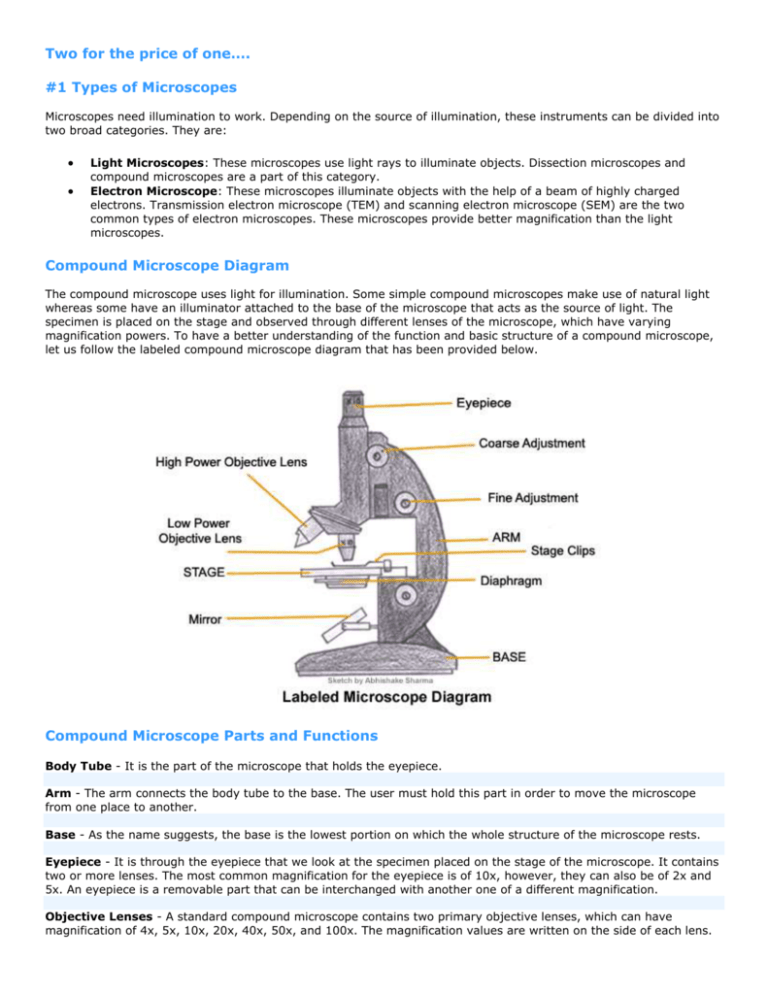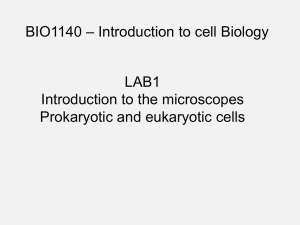parts of a microscope
advertisement

Two for the price of one…. #1 Types of Microscopes Microscopes need illumination to work. Depending on the source of illumination, these instruments can be divided into two broad categories. They are: Light Microscopes: These microscopes use light rays to illuminate objects. Dissection microscopes and compound microscopes are a part of this category. Electron Microscope: These microscopes illuminate objects with the help of a beam of highly charged electrons. Transmission electron microscope (TEM) and scanning electron microscope (SEM) are the two common types of electron microscopes. These microscopes provide better magnification than the light microscopes. Compound Microscope Diagram The compound microscope uses light for illumination. Some simple compound microscopes make use of natural light whereas some have an illuminator attached to the base of the microscope that acts as the source of light. The specimen is placed on the stage and observed through different lenses of the microscope, which have varying magnification powers. To have a better understanding of the function and basic structure of a compound microscope, let us follow the labeled compound microscope diagram that has been provided below. Compound Microscope Parts and Functions Body Tube - It is the part of the microscope that holds the eyepiece. Arm - The arm connects the body tube to the base. The user must hold this part in order to move the microscope from one place to another. Base - As the name suggests, the base is the lowest portion on which the whole structure of the microscope rests. Eyepiece - It is through the eyepiece that we look at the specimen placed on the stage of the microscope. It contains two or more lenses. The most common magnification for the eyepiece is of 10x, however, they can also be of 2x and 5x. An eyepiece is a removable part that can be interchanged with another one of a different magnification. Objective Lenses - A standard compound microscope contains two primary objective lenses, which can have magnification of 4x, 5x, 10x, 20x, 40x, 50x, and 100x. The magnification values are written on the side of each lens. The objective turret to which these lenses are attached, can be manually rotated to get the lens to give the desired magnification and focus of the specimen. Stage - is the platform below the objective lens on which the object or specimen to be viewed is placed. There is a hole in the stage through which light beam passes and illuminates the specimen that is to be viewed. Stage Clips - There are two stage clips, one on each side of the stage. Once the slide containing the specimen is placed on the stage, the stage clips are used to hold the slide in place. Diaphragm - is located on the lower surface of the stage. It is used to control the amount of light that reaches the specimen through the hole in the stage. Illuminator - Simple compound microscopes have a mirror that can be moved to adjust the amount of light that is focused on the specimen. However, some advanced types of compound microscopes have their own light source. The Adjustments - There are two adjustment knobs, the fine adjustment knob and the coarse adjustment knob. The coarse adjustment knob helps in improving the focus at a low power, whereas the fine adjustment knob helps in adjusting the focus of the lenses with higher magnification. http://www.buzzle.com/articles/microscope-diagram-and-functions.html #2 Here are the important microscope parts... Eyepiece: The lens the viewer looks through to see the specimen. The eyepiece usually contains a 10X or 15X power lens. Diopter Adjustment: Useful as a means to change focus on one eyepiece so as to correct for any difference in vision between your two eyes. Body tube (Head): The body tube connects the eyepiece to the objective lenses. Arm: The arm connects the body tube to the base of the microscope. Coarse adjustment: Brings the specimen into general focus. Fine adjustment: Fine tunes the focus and increases the detail of the specimen. Nosepiece: A rotating turret that houses the objective lenses. The viewer spins the nosepiece to select different objective lenses. Objective lenses: One of the most important parts of a compound microscope, as they are the lenses closest to the specimen. A standard microscope has three, four, or five objective lenses that range in power from 4X to 100X. When focusing the microscope, be careful that the objective lens doesn’t touch the slide, as it could break the slide and destroy the specimen. Specimen or slide: The specimen is the object being examined. Most specimens are mounted on slides, flat rectangles of thin glass. The specimen is placed on the glass and a cover slip is placed over the specimen. This allows the slide to be easily inserted or removed from the microscope. It also allows the specimen to be labeled, transported, and stored without damage. Stage: The flat platform where the slide is placed. Stage clips: Metal clips that hold the slide in place. Stage height adjustment (Stage Control): These knobs move the stage left and right or up and down. Aperture: The hole in the middle of the stage that allows light from the illuminator to reach the specimen. On/off switch: This switch on the base of the microscope turns the illuminator off and on. Illumination: The light source for a microscope. Older microscopes used mirrors to reflect light from an external source up through the bottom of the stage; however, most microscopes now use a low-voltage bulb. Iris diaphragm: Adjusts the amount of light that reaches the specimen. Condenser: Gathers and focuses light from the illuminator onto the specimen being viewed. Base: The base supports the microscope and it’s where illuminator is located. http://www.microscopemaster.com/parts-of-a-compound-microscope.html








